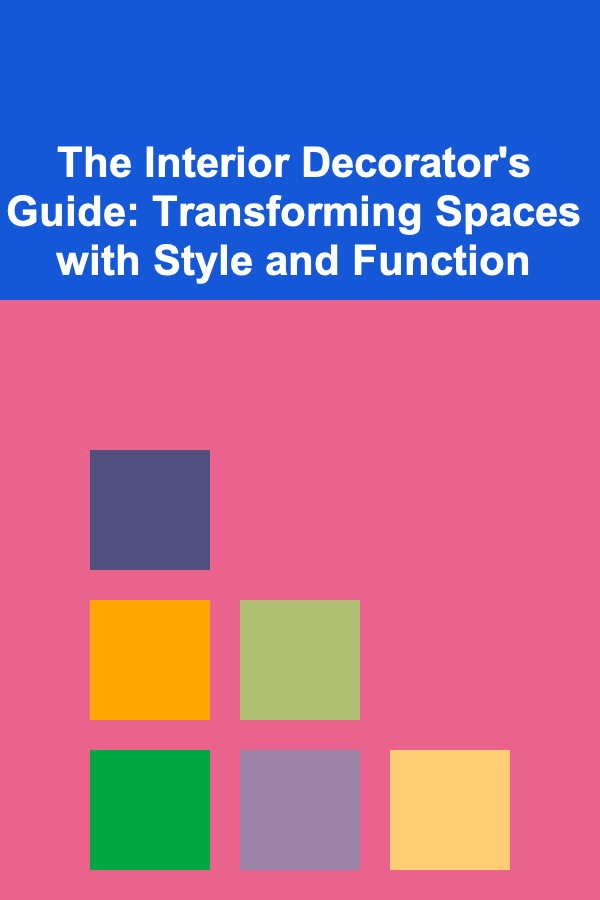
The Interior Decorator's Guide: Transforming Spaces with Style and Function
ebook include PDF & Audio bundle (Micro Guide)
$12.99$5.99
Limited Time Offer! Order within the next:

Interior decorating is much more than choosing colors, arranging furniture, and selecting accessories. It's about creating environments that reflect the personality of the people living or working in a space while also providing comfort, functionality, and aesthetic appeal. Whether you're a professional interior decorator or someone looking to enhance your own space, this actionable guide will walk you through the steps to transform any room into a harmonious, stylish, and functional environment.
Understanding the Basics of Interior Decorating
Before diving into design specifics, it's essential to understand the fundamental principles that guide interior decorating. These principles will provide the foundation for any project and ensure a cohesive look and feel.
1. Balance
Balance refers to the visual distribution of elements within a room. There are three types of balance in interior design:
- Symmetrical Balance: Elements are arranged evenly on either side of a central axis, creating a formal and organized feel.
- Asymmetrical Balance: Distributes visual weight in an uneven but still harmonious manner. It often creates a more dynamic, relaxed look.
- Radial Balance: Elements are arranged around a central point, often used in circular or rounded spaces.
2. Harmony and Unity
This principle emphasizes the need for all elements within a space to work together, contributing to an overall sense of cohesion. It's important to consider how colors, textures, shapes, and styles can complement each other to create a unified look.
3. Proportion and Scale
Proportion refers to the size relationships between objects within a space. Scale deals with the size of furniture and decor in relation to the room. For example, large furniture in a small room can make the space feel cramped, while smaller pieces in a large room may seem lost. The key is finding the right balance between both.
4. Rhythm
Rhythm is about creating a flow within a space. This can be achieved through repeated patterns, colors, shapes, and textures that guide the eye around the room. Think of rhythm as creating a visual movement, where elements lead from one part of the room to another.
5. Contrast
Contrast highlights differences between elements, such as color, texture, or form. This helps to create visual interest and avoid monotony. Bold contrasts, like pairing light and dark shades or mixing sleek modern furniture with vintage pieces, can create striking focal points within a room.
Step-by-Step Guide to Transforming Your Space
Now that you understand the core principles, let's break down the process of transforming your space. This guide will walk you through actionable steps to create a stylish and functional environment.
1. Define the Purpose of the Space
The first step in any design project is to define the purpose of the room. Ask yourself:
- Will this space be used for relaxation, work, or socializing?
- How many people will be using it at once?
- What activities will take place here (e.g., reading, cooking, hosting parties)?
Understanding the purpose will guide every design decision, from layout to furniture selection and decor choices. For example, a living room meant for family gatherings will differ greatly from a home office, which requires functionality and focus.
2. Choose a Color Scheme
Color sets the mood of a space. Whether you're aiming for a calm, serene atmosphere or an energetic, bold vibe, your color palette is key.
- Neutral Tones: Whites, grays, and beiges are timeless and versatile. They provide a backdrop for other colors and allow you to play with textures and accessories.
- Bold Colors: If you're aiming for a lively, modern space, rich tones like navy, emerald, or mustard can add depth and drama.
- Accent Colors: Use accent colors to add personality to a room. These are typically used in smaller quantities for accessories like pillows, artwork, or rugs.
When selecting a color scheme, always consider how natural light affects the shades throughout the day. Dark colors can make a room feel cozier but can also make smaller spaces feel cramped. Light tones help open up a room but may lack the warmth of deeper hues.
3. Focus on Functionality First
While aesthetics are crucial, function should always come first. Begin by selecting the most functional pieces of furniture for the space. This includes considering:
- Ergonomics: Ensure that seating, desks, and tables are comfortable and well-suited for their intended use.
- Storage Solutions: Make sure that you have sufficient storage options, whether it's shelves, cabinets, or multifunctional furniture.
- Traffic Flow: Arrange furniture to ensure that the space remains accessible and easy to navigate.
A beautifully designed space is only successful if it also serves the practical needs of its inhabitants.
4. Choose Furniture That Complements the Room's Purpose
Now that you've defined the space's function, choose furniture that supports that function while also enhancing the style. Consider the following:
- Size and Scale: Choose furniture that fits the scale of the room. Avoid overcrowding a small space with oversized furniture.
- Style: Whether you're going for modern, traditional, industrial, or eclectic, make sure the furniture complements your chosen aesthetic.
- Material and Texture: Mix and match materials for interest. For example, wood and metal can work together beautifully, while velvet and leather offer tactile contrast.
Invest in quality pieces for the most-used items, such as sofas, tables, and chairs, as these will contribute significantly to both the function and style of the space.
5. Play with Lighting
Lighting plays an essential role in setting the mood and making a space feel welcoming and functional. Layer your lighting with:
- Ambient Lighting: This is your primary source of light, typically from overhead fixtures or soft, recessed lighting.
- Task Lighting: Focused lighting used for specific activities, like reading lamps, desk lights, or under-cabinet lighting.
- Accent Lighting: Used to highlight architectural features or artwork, like spotlights or LED strips.
Adjust the lighting based on the time of day and the activity happening in the space. For example, soft lighting works well for a cozy living room, while bright, focused lighting is essential in a kitchen or office.
6. Add Personal Touches with Accessories
Accessories are the finishing touches that transform a room from "designed" to "lived-in." These elements add character and warmth. Some great ways to personalize a space include:
- Art and Photography: Create a gallery wall, or display individual pieces that resonate with you.
- Textiles: Add texture and comfort with pillows, throws, and rugs. These items also allow you to introduce color and patterns without overwhelming the space.
- Plants: Incorporate greenery to bring life and freshness to the room. Plants also improve air quality and add a natural element to the decor.
When adding accessories, keep in mind the balance and rhythm you want to create. Avoid overcrowding shelves or tables with too many items. Choose pieces that contribute to the overall harmony of the space.
7. Maintain Flexibility
As trends evolve and your needs change, your space may need to evolve too. Interior decorating doesn't have to be a one-time process. Stay open to adjusting layouts, switching out decor, or updating furniture to keep your space fresh and functional. This adaptability ensures that your home continues to reflect your lifestyle and personality.
Conclusion: Creating Spaces That Inspire
Interior decorating is a dynamic blend of creativity and functionality. By considering both the practical needs and aesthetic desires of a space, you can create environments that are not only beautiful but also comfortable and efficient. Use this guide as a starting point to transform any room into a reflection of your unique style and needs. With a little thought and intention, every space can become a perfect blend of form and function, offering a harmonious retreat that works for you.

How to Build a Personal Budget That Works for Your Lifestyle
Read More
How to Create a Checklist for Industrial Equipment Safety Inspections
Read More
How to Create a Milestone Photo Album for Kids
Read More
How to Make a Checklist for Demolition and Site Preparation
Read More
How to Make a Checklist for Ensuring Cross-Department Collaboration During Onboarding
Read More
How to Refresh Your Bedroom Decor Without Spending a Fortune
Read MoreOther Products

How to Build a Personal Budget That Works for Your Lifestyle
Read More
How to Create a Checklist for Industrial Equipment Safety Inspections
Read More
How to Create a Milestone Photo Album for Kids
Read More
How to Make a Checklist for Demolition and Site Preparation
Read More
How to Make a Checklist for Ensuring Cross-Department Collaboration During Onboarding
Read More